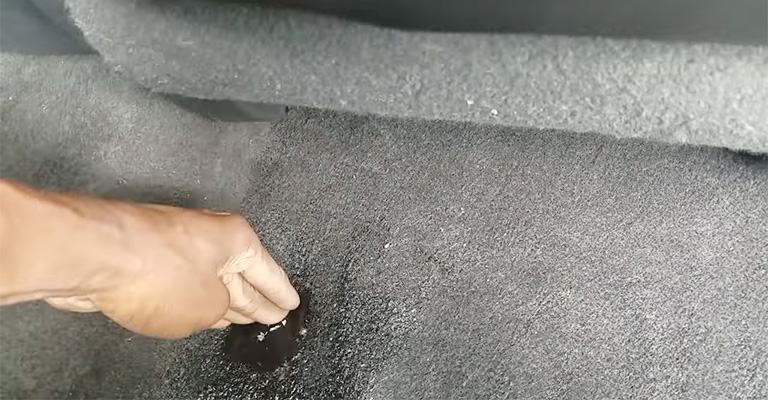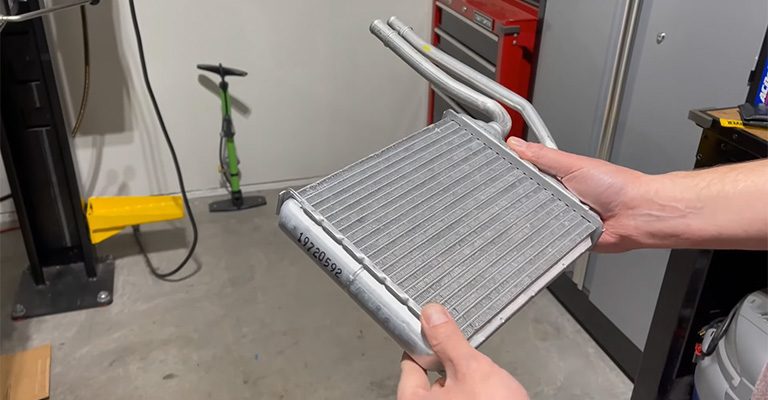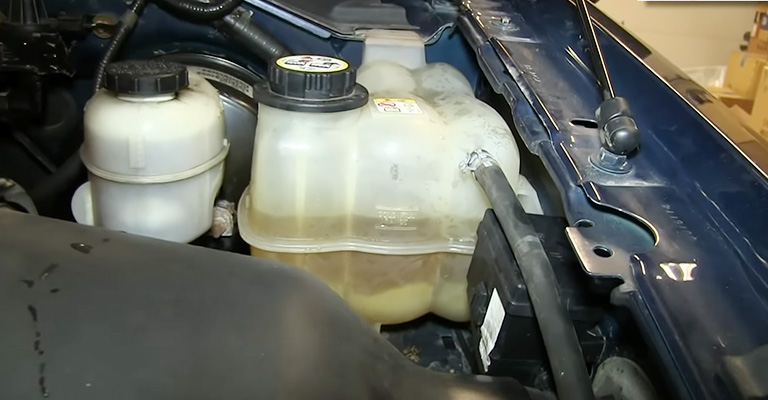If the water is only on the passenger side rear floorboard, the issue may be with the seals around the windows or doors on that side of the car.
It’s also possible that the water is coming from the air conditioning system if it is not properly draining. If the leak is severe, it could damage your car’s interior and lead to mold growth.
It’s best to have a mechanic take a look at your car and determine the cause of the leak. Before that, you need to know about several possible reasons why the floorboard of your Honda Accord may be wet. Some of the most common reasons include:

A leak in the roof or windows:
If your Honda Accord has a leak, water can seep into the car and collect on the floorboards.
A clogged sunroof drain:
If your Honda Accord has a sunroof, the drain for the sunroof may be clogged. This can cause water to build up and leak onto the floorboards.
A leak in the heater core:
The heater core is responsible for providing heat to your car’s interior. If it develops a leak, it can cause water to drip onto the floorboards.
A leak in the air conditioning system:
The air conditioning system in your Honda Accord is responsible for cooling the air inside the car. If it develops a leak, it can cause water to drip onto the floorboards.
If you are unsure of the cause of the wetness in your Honda Accord’s floorboard, it is recommended that you take it to a mechanic for inspection and repair.
Honda Accord Rear Floorboard Wet: Common Reasons Explained

Occasionally, my driver’s front carpet will get wet, and my rear carpet has been wet once. When I removed the headliner, I found that the sunroof drains were working fine and not clogged.
There are still occasional wet patches. All I can recommend is that you always close your sunroof.
As for why your Honda Accord’s rear floorboard gets wet, your first guess is as good as mine.
Perhaps there is a leak coming from the sunroof. Could this be the cause? If my sunroof leaks, probably the drains are to blame. Can they be cleaned out or tested to ensure they are working? How else can my carpets stay damp?
This is a problem that I found on one of the Honda Accord forums. The problem is quite common, and there is a simple solution to it. If your rear floorboard has a hole or two or the drain hole rubber is missing, it could be a problem.
It will take months for the wet underside of the carpet to dry up, so you should remove it and check the floorboards. Your floors will rust if you don’t do this. Surface rust was already present in mine.
It’s possible to prevent these things from happening, but if you don’t address them, they’ll happen again. Here are some tips for getting rid of wet surfaces in your car.
As well as discussing how to keep your car dry, we’ll also go over important details. Wet car floor surfaces can be attributed to the following reasons.
1. The Heater Core Is Bad

A heater core may appear like a simple device, but it can cause serious problems if installed incorrectly. Because the part is located behind the dashboard, it is costly to replace. What are the signs that your car’s heater core is failing? The signs are as follows.
An Engine That Is Overheating:
The engine can overheat if there is low coolant level. Leaving the engine unattended may cause it to become damaged. Overheating can also occur due to a clogged heater core, which prevents coolant flow.
Low Coolant Level:
Low coolant levels are likely to cause severe heater core problems.
The Floor Is Accumulating Coolant:

Due to the heater core’s location behind the dashboard, if coolant collects on the floor, then the heater core leaks.
Formation Of Fog:
Whenever there is a leak in the heater core, fog will begin to form due to the coolant vapor traveling to the unfreeze vents. The coolant from the leaking core will smell sweet if you wipe off the fog on your windshield.
Insufficient Heat:
There is a possibility that the car will run poorly due to a faulty heater. When the coolant flow to the core is obstructed, the core will be unable to keep the cabin warm.
There are cases where the heater core becomes weak over time and leaks form. There are instances, however, when failure to maintain the core prematurely results in the core’s early demise.
2. Bad AC Evaporator

There is a possibility of rainwater entering the vehicle when the car’s windows leak, but what about on a sunny day? Something is wrong under the hood.
Cooler air is produced inside the car’s cabin and warm air is drawn out of it by the air conditioning system. Warm and humid air will be drawn out of the vehicle by the evaporator of the air conditioner. The water will drain while you drive.
Evaporators are usually located underneath dashboards. Dirt and dust accumulate in the condensation system, which causes it to become clogged and leak. If you notice a puddle on the passenger side carpet, you might have a bad air conditioner evaporator.
3. Windows That Leak
Rainwater can pass through small holes in a vehicle’s windows and windshield. Black rubber seals (weatherstripping) that seal the window glass on your car will dry over time.
Leaks will occur when it becomes damaged and brittle. Rainwater can enter the vehicle if the weatherstripping is torn. Make sure the weatherstripping on your car is in good shape if you plan to park outside. Having the seals replaced by a professional is an option.
4. The Doors Are Leaking
There is no airtight seal on automotive doors. There is no airtight seal on automotive doors. There are holes at the bottom of the car’s door where water falls from the door’s protective sheet.
The effectiveness of these membranes will be compromised if they become damaged and old. The drain holes in the car will drain any water collected within the car, but they may clog up too.
Water will then enter the cabin as a result of this action. Make sure the drain holes under the door are not blocked.
5. The Sunroof Is Leaking
There is a seal on every car’s sunroof. Nevertheless, these seals aren’t tight enough to hold water, so water drains through them. The sunroof tray has holes in the corners to drain the water. The obvious metal frame is the sunroof tray.
Water will drain into the vehicle’s floor as the rain starts falling and the sunroof is retracted. Dust and leaves will clog the holes when you open the sunroof repeatedly. There will be leaks in the cabin as a result of the rain.
What Should You Do If You Find A Leak In Your Honda Accord?
The cabin must be thoroughly dried once the leak has been located, as damp surfaces promote mold growth. The car may be clean, but mold could be present in the carpet, windows, or doors, making it smell bad.
You can easily remove carpets, door panels, and seats. Wet items should be dried in the sun if they are wet. Once the floor is completely clean, mop up any remaining liquid. Clean your car with a disinfectant to prevent bacteria from growing.
Close all windows after drying and use a dehumidifier. You will be able to see and smell a clean car after doing this. The car will have to dry completely before driving, so open all the windows and turn on the heater when you drive.
What Will Happen If The Rear Carpet On My Honda Accord Gets Wet?
Getting the Honda Accord’s rear carpet wet will affect it in the following ways: If the carpet in the rear of a Honda Accord gets wet, it can lead to various negative effects.
First and foremost, the wet carpet can become a breeding ground for mold and mildew, which can cause a musty odor and potentially lead to health problems if inhaled.
Additionally, the wet carpet can become damaged, affecting the vehicle’s overall appearance and value.
Furthermore, the wet carpet can also lead to rust and corrosion on the metal components underneath, which can compromise the vehicle’s structural integrity.
It is important to address any wet carpeting in a vehicle as soon as possible to avoid these potential negative effects.
Final Words
Water dripping from the doors is the most likely the main cause. A drain hole is located at the bottom of each door to let water out. All the internal components of the door bend sideways towards the plastic panel inside the door.
As long as the plastic sheet underneath the door panel is installed correctly, this should not be a problem. This will allow water to run down the sheeting and be redirected to the central portion of the door.
Drains flow out through drain holes in the bottom of the door and through a drain hole in the bottom of the plastic sheeting.
There is a non-hardening sealant holding the plastic sheeting in place, which may have to be reapplied at the bottom of the drain hole. If something is clogging them up, it will make your Honda Accord’s rear floorboard wet.

Leave a Reply